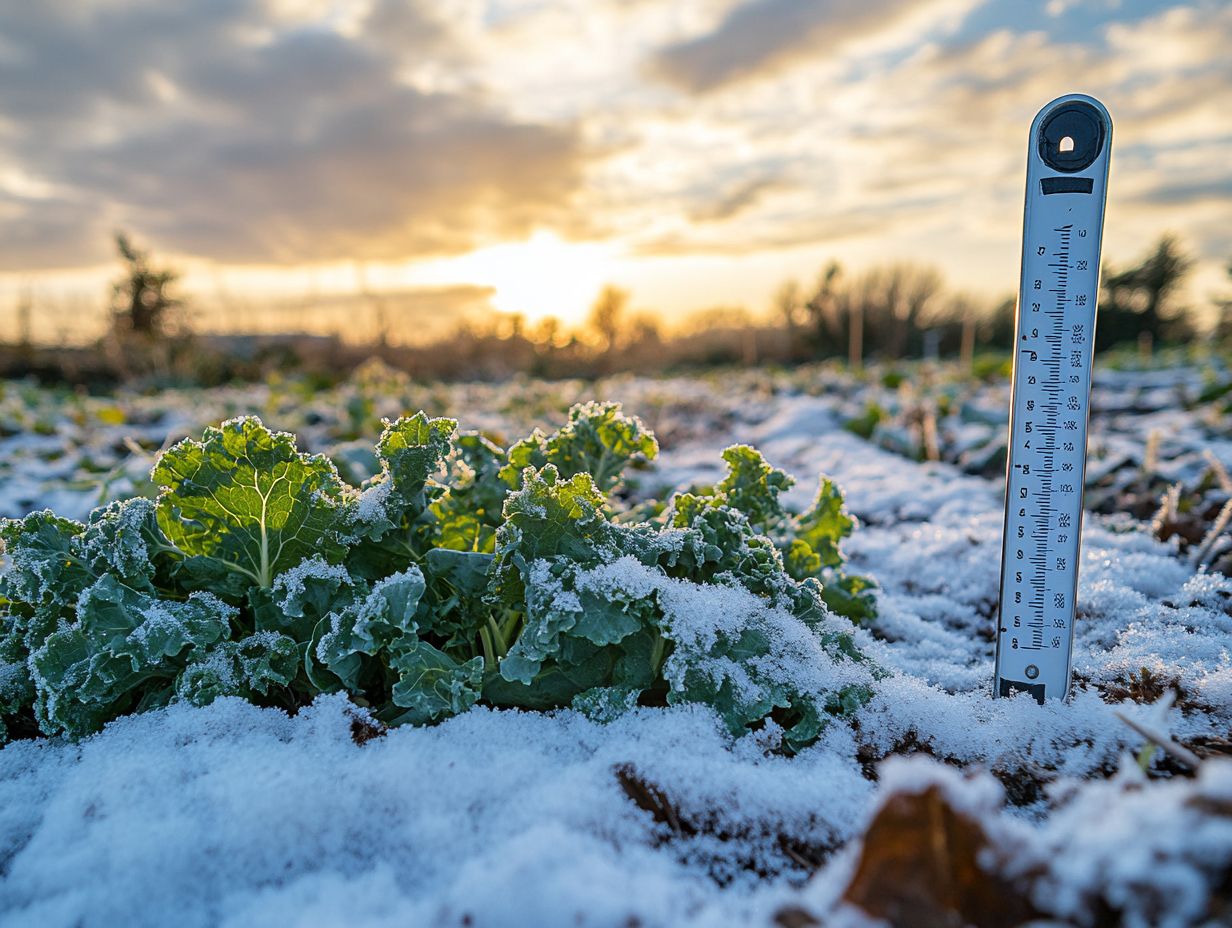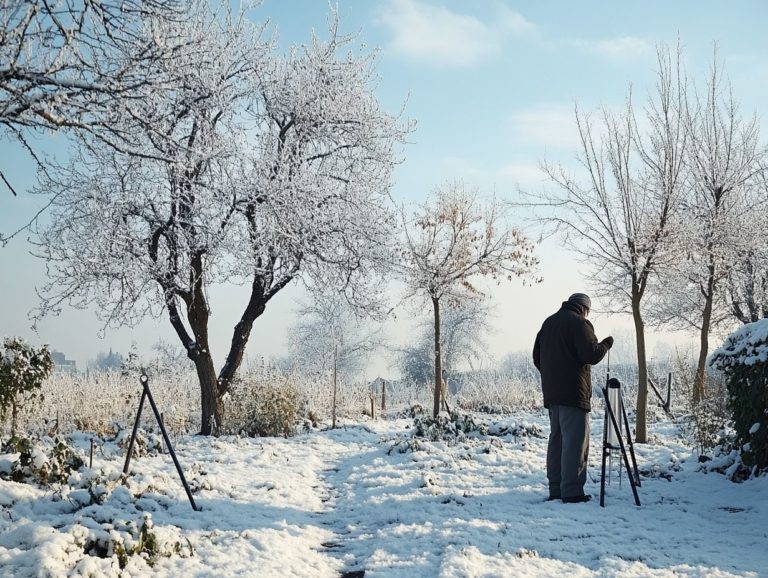Soil Temperature: Its Role in Cold-Climate Gardening
Soil temperature plays a pivotal role in your gardening success, especially in colder climates where every degree matters. It directly impacts your farming practices.
By understanding how different temperatures influence plant growth and crop development, you can unlock the secret to a flourishing garden. Let’s dive into the factors that affect soil temperature, including climate, soil composition, atmospheric conditions, and sun exposure. This article outlines the optimal temperature ranges for various plants and shares effective strategies for managing soil warmth in brisk conditions, enhancing soil moisture retention.
You’ll also discover handy tools to help you monitor and maintain the ideal soil temperature. Soil sensors provide accurate temperature measurements, ensuring your garden thrives. Join us as we explore the essential connection between soil temperature and your gardening achievements, including the role of snow in cold-climate gardening, which highlights the importance of vegetation cover in maintaining ground warmth.
Contents
- Key Takeaways:
- The Importance of Soil Temperature in Gardening
- Factors Affecting Soil Temperature
- Optimal Soil Temperature for Plant Growth
- Managing Soil Temperature in Cold Climates
- Essential Tools for Monitoring Soil Temperature
- Frequently Asked Questions
- 1. How does Soil Temperature affect Plant Growth in cold-climate gardening?
- 2. What is the optimal soil temperature for cold-climate gardening in relation to Weather?
- 3. How can I measure Soil Temperature and Soil Moisture in my garden?
- 4. Why is it important to monitor Soil Temperature and its Biological Properties in cold-climate gardening?
- 5. How does Soil Temperature affect seed germination and Vegetation in cold-climate gardening?
- 6. How can I adjust Soil Temperature and promote soil solarization for cold-climate gardening?
Key Takeaways:

- Soil temperature is crucial for gardening, affecting plant growth and survival. Understanding its role is essential for successful cold-climate gardening.
- Factors like climate, soil composition, and sun exposure influence soil temperature. Manipulating these factors helps maintain optimal temperatures for plant growth.
- Use insulation and smart tools to monitor soil temperature in colder climates, ensuring healthy and thriving plants.
The Importance of Soil Temperature in Gardening
Soil temperature significantly impacts plant growth, crop development, and nutrient uptake. For you as a gardener, understanding the soil temperature is vital; it directly affects soil moisture levels and the overall health of your plants.
When soil temperatures are ideal, photosynthesis flourishes, leading to bountiful crop yields. Conversely, if temperatures are too low or too high, plant processes can be stifled, hindering growth. This makes it crucial to monitor and manage soil temperature effectively to optimize photosynthesis.
Using modern tools and techniques, like soil sensors and satellite data, gives you the power to ensure your gardening efforts yield the best possible results.
Understanding the Role of Soil Temperature
Soil temperature is essential to your plants’ growth processes, influencing everything from nutrient uptake to moisture retention. Understanding the role of earthworms in cold-climate soil can further enhance these factors.
When the soil temperature is in the sweet spot, nutrients become more accessible, allowing your plants to efficiently absorb vital elements like nitrogen and phosphorus. However, when temperatures stray too low or high, nutrient availability can suffer, hindering growth.
Temperature also significantly influences moisture levels. Warmer soils can increase evaporation, reducing water availability for crops. Soil microorganisms, crucial for breaking down organic matter, are particularly sensitive to temperature changes. In warmer soils, microbial activity thrives, speeding up the decomposition of organic materials and enriching the soil. Cooler soils can slow this process, adversely affecting the health and nutrient content of your crops.
Factors Affecting Soil Temperature
Numerous factors influence soil temperature, including climate, seasonal variations, soil composition, and sun exposure. Each of these elements plays a crucial role in shaping the thermal conditions of the ground.
Understanding this interplay enhances your appreciation of soil dynamics and its impact on the environment.
Ready to boost your garden s success? Let s explore how soil temperature can help you thrive!
Climate and Seasonal Changes

Climate and seasonal changes wield significant influence over soil temperature, which is crucial for understanding what to know about soil fertility in cold climates, guiding you on the optimal times for planting and harvesting.
When temperature variations occur, they can shift soil warmth, which in turn affects root development and seed germination. For example, in temperate regions, soil warms up earlier in spring, providing perfect conditions for planting cool-season crops.
On the flip side, if you re in an area that experiences extreme heat, those elevated soil temperatures might require you to implement mulching or provide shade to safeguard delicate root systems from scorching.
By keeping a close eye on seasonal patterns and adjusting your planting schedules accordingly, you can make informed decisions that enhance your crop yield. Customizing your irrigation practices based on rain patterns helps maintain optimal moisture levels, creating a harmonious environment for robust growth.
Soil Composition and Sun Exposure
The composition and texture of the soil, along with sun exposure, are pivotal in determining its temperature.
You ll find that different soil types whether sandy, loamy, or clay-rich have distinct capacities for heat retention.
Sandy soils warm up swiftly under the sun but lose that warmth just as quickly when evening falls, making them less suitable for certain plants. In contrast, loamy soils hold onto warmth longer, which is advantageous for cultivating a diverse array of crops.
By choosing a planting location that enjoys ample sunlight throughout the day, you can enhance the soil’s temperature, creating a nurturing environment for robust plant growth. Careful planning in these areas can ultimately lead to a more rewarding gardening experience.
Optimal Soil Temperature for Plant Growth
Optimal soil temperature is crucial for your plant growth. It directly affects crop development, nutrient availability, and the overall properties of the soil.
Ensuring the right temperature can make all the difference in cultivating a thriving garden or farm.
Recommended Temperature Ranges for Different Plants
Different plants have their own optimal soil temperature ranges that are essential for flourishing growth and development.
For instance, if you re cultivating cool-season crops like spinach and lettuce, they thrive best when soil temperatures hover between 50 F and 65 F. This range lets them soak up nutrients like a sponge, leading to lush, vibrant foliage!
On the flip side, if you re tending to warm-season crops such as tomatoes and peppers, they crave warmer soil, ideally between 70 F and 85 F, to truly maximize their growth potential and fruit production.
By understanding these temperature nuances, you ensure healthier plants and gain valuable insights for making informed decisions about your planting schedules. Are you ready to give your plants the best chance to thrive?
Managing Soil Temperature in Cold Climates

Managing soil temperature in cold climates is crucial for fostering healthy plant growth and maximizing crop yields. You might need to use creative techniques like insulation and covering soil with plastic to keep your plants warm.
Start planning your garden today, and watch your plants flourish!
Insulation and Other Techniques
Insulation techniques are vital for managing soil temperature in cold climates. They ensure your crops are protected and primed for growth.
Methods like applying a generous layer of organic mulch or using row covers are crucial for retaining warmth in the soil. By creating a barrier, mulch effectively insulates the ground, minimizing heat loss during chilly nights.
Row covers do double duty they trap heat and shield your plants from harsh winds and frost.
Using soil solarization can significantly warm the soil, boosting microbial activity and nutrient availability. When you combine this with insulation techniques, you re fostering optimal growing conditions and encouraging robust plant health and impressive yields.
It s crucial to adopt an integrated approach to garden management for the best results!
Essential Tools for Monitoring Soil Temperature
Monitoring soil temperature is essential for achieving success in your gardening endeavors. It also helps you understand the chemical properties of the soil. Various tools, such as soil sensors and thermometers, are available to help you measure temperature accurately and effectively.
Types of Thermometers and Their Uses
Soil thermometers come in many types and are essential for accurately measuring soil temperature in your gardening and farming endeavors.
These devices range from straightforward dial thermometers to sophisticated digital models. Each offers unique features tailored to your specific gardening needs.
For example, digital soil thermometers often deliver quick readings and may even boast data logging capabilities. This allows you to track temperature changes over time effortlessly.
Accurate soil temperature readings are critical. They guide you in determining the optimal planting times and shape your decisions regarding crop maintenance. By selecting the right type of thermometer and utilizing it effectively, you can optimize your gardening practices, resulting in healthier plants and improved yields, whether in your home garden or larger agricultural operations.
Frequently Asked Questions

1. How does Soil Temperature affect Plant Growth in cold-climate gardening?
Soil temperature plays a crucial role in plant growth and development. In cold-climate gardening, low soil temperatures can slow down or even halt plant growth, while the role of soil in sustainable cold-climate gardening highlights how warmer soil temperatures promote healthy growth.
Understanding soil properties, such as soil texture and soil moisture, is essential to optimizing conditions for crops.
2. What is the optimal soil temperature for cold-climate gardening in relation to Weather?
The ideal soil temperature for most plants in cold-climate gardening is between 50-65 degrees Fahrenheit. This range allows for proper root development and nutrient uptake, making it crucial to consider understanding microclimates in your cold garden, leading to strong and healthy plants.
3. How can I measure Soil Temperature and Soil Moisture in my garden?
You can use a soil thermometer to measure the temperature of your garden’s soil. Insert the thermometer into the soil at least 6-8 inches deep for an accurate reading.
You can also use a digital thermometer with a probe to measure soil temperature at different depths.
4. Why is it important to monitor Soil Temperature and its Biological Properties in cold-climate gardening?
Monitoring soil temperature is critical in cold-climate gardening to ensure that plants are receiving the right conditions for growth, making the importance of soil testing even more essential.
It helps you determine when to plant, water, and fertilize, as well as identify potential issues with soil temperature affecting plant growth.
5. How does Soil Temperature affect seed germination and Vegetation in cold-climate gardening?
Seeds require a specific range of soil temperatures to germinate successfully. In cold-climate gardening, understanding soil needs for cold-climate plants is crucial; if the soil temperature is too low, seeds may not germinate at all, or it may take a longer time for them to sprout.
Ensuring the right soil temperature can lead to better and faster seed germination.
6. How can I adjust Soil Temperature and promote soil solarization for cold-climate gardening?
There are several ways to adjust soil temperature in cold-climate gardening. Adding natural materials like compost can protect and warm the soil.
Mulching regulates soil temperature by keeping it warm during cold weather and cool in hot weather. Row covers or cold frames create a warmer space for plants in the cold. Start preparing your garden today!






